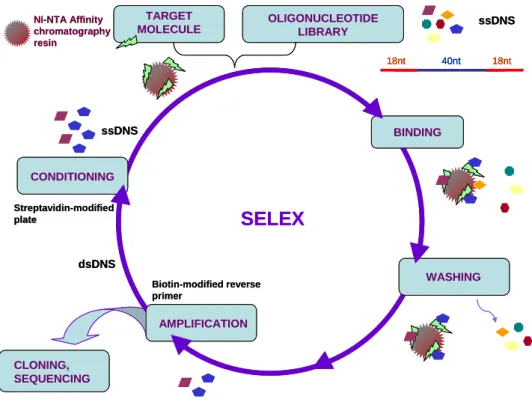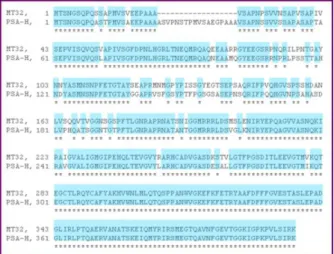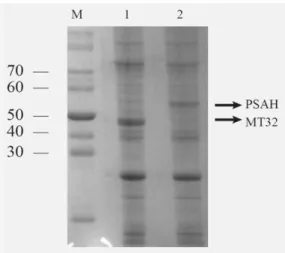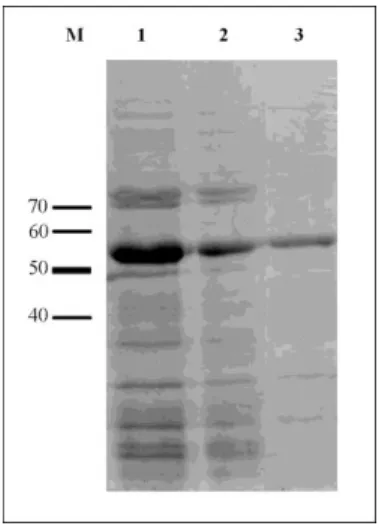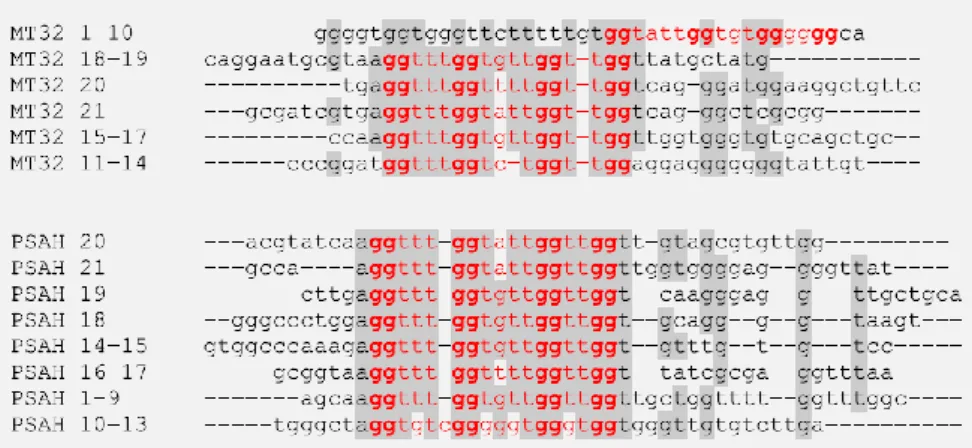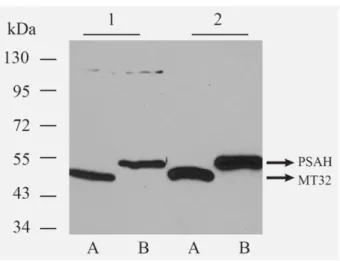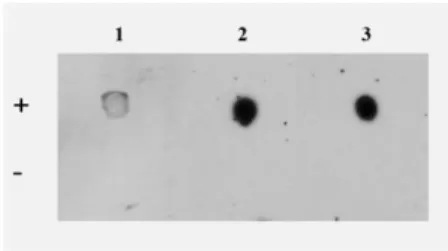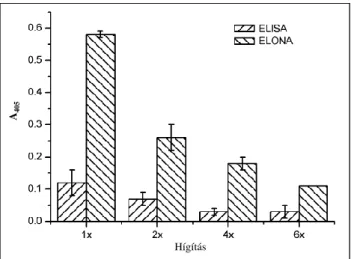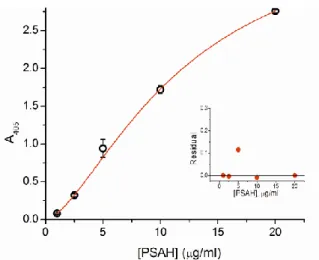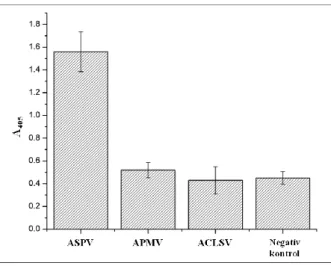Plant virus detection using aptamers
Ph.D. thesis
Balogh Zsófia
Semmelweis University
School of Ph.D. Molecular Medicine
Supervisor: Tamás Mészáros, Ph.D.
Official reviewers: György Berencsi, Ph.D.; Attila Ambrus, Ph.D.
Comprehensive exam committee
President: Raymund Machovich, Ph.D., D.Sci.
Members: Katalin Jemnitz, Ph.D.; Miklós Geiszt, Ph.D.
Budapest
2011
Introduction
Characterization of aptamers
The vast majority of diagnostic methods are based on the specific detection and quantification of protein of interest. These examinations can be conducted by enzyme activity measurements –if the protein has characteristic enzymatic activity- or directly by quantitative protein measurements. The latter protocols are usually based on a receptor molecule, which binds the protein with high affinity and specificity. Nowadays, the most popular receptor molecules are antibodies, but ca. 20 years ago their alternatives, the so called aptamers, have appeared. Aptamers are single stranded oligonucleotides, which can selectively bind proteins and small molecules. The research performed over the past period has demonstrated that aptamers can often substitute or in many cases even exceed antibodies as receptor molecules.
Due to their in vitro selection and production aptamers are very promising synthetic receptor molecules. Their production does not require any animals or specific cell lines, so theoretically, aptamers can be produced for any kind of toxic or poorly immunogenic target molecule. In addition, the selection conditions can be far from physiological circumstances and freely modified, thus it can be optimized for the intended application of aptamer. As the nucleotide sequences of the selected aptamers are known, they can be chemically reproduced in a highly pure form at any time. Though aptamers have a simpler chemical structure, and smaller size compared to antibodies, their affinity and specificity can be very high, and their dissociation constant, similarly to antibodies, lies in the μM-pM range. Their long term stability is better, and they are less sensitive to temperature changes than antibodies due to their phosphodiester bond and regeneration capability after denaturation. As aptamers are nucleic acids, it is easy to perform controlled modifications on them using various kinds of functional groups or tags.
SELEX- the aptamer selection process
SELEX is an iterative process in which the in vitro selection and amplification steps alternate.
The basis of the typical SELEX process is a chemically constructed random oligonucleotide library, which usually consists of 1013-1015 different oligonucleotides. Each oligonucleotide contains a 20-80 nucleotide random region located between two 18-21 nucleotide primer
binding regions, which are required for the amplification step. Similarly to the Darwinian selection process, the impact of selection pressure results in a relatively small number of sequences with optimal structural motifs for target binding. During the selection, target molecule recognizing oligonucleotides of the library are bound to their target, separated from the unbound sequences and amplified. This way the resulting oligonucleotide library used in the next SELEX cycle is enriched for target molecule-binding sequences. Due to the iterative process, the primary random oligonucleotide library is reduced to a relatively small number of sequences, which can bind the target molecule with the highest affinity and specificity (figure 1.). A successful aptamer selection process usually comprises 5-15 cycles. Following the last SELEX cycle, the sequences of selected aptamers are determined. The most frequently occurring and most similar sequences are selected by alignment analysis. Finally, the binding capacity, affinity and specificity of the selected sequences are analyzed and characterized by various methods.
Since 1990, aptamers have been selected for various target molecules, including inorganic substances, organic small molecules, peptides, proteins, carbohydrates, and antibiotics. One of the most important characteristics of the SELEX process that it can be applied for a mixture of target molecules, even whole cells, tissues, bacteria or viruses in addition to a defined target molecule.
CONDITIONING
AMPLIFICATION
WASHING BINDING TARGET
MOLECULE OLIGONUCLEOTIDE LIBRARY
CLONING, SEQUENCING
SELEX
dsDNS ssDNS
18nt
18nt 40nt
Ni-NTA Affinity chromatography resin
Biotin-modified reverse primer
Streptavidin-modified plate
ssDNS
CONDITIONING
AMPLIFICATION
WASHING BINDING TARGET
MOLECULE OLIGONUCLEOTIDE LIBRARY
CLONING, SEQUENCING
SELEX
dsDNS ssDNS
18nt
18nt 40nt 18nt
18nt 40nt
Ni-NTA Affinity chromatography resin
Biotin-modified reverse primer
Streptavidin-modified plate
ssDNS
Figure 1: The flow chart of the SELEX process.
Characterization of the aptamer-target molecule interaction
The target molecule binding capacity of aptamers is facilitated by proper structural fit, the formation of hydrogen bonds, interactions between aromatic compounds, electrostatic and van der Waals interactions, and the combinations of these effects. Most of the aptamers achieve a stable secondary structure by adaptive conformation change while binding to the target molecule. However, in the absence of the target molecule they have an unorganized structure.
Interactions between aptamers and small molecules elicit folding into a pocket-like three dimensional binding structure, which can cover the whole target molecule. In case of larger molecules like proteins, aptamers fit the target molecule. Some of the nucleotides of aptamers bind the target molecule directly, while others contribute to the proper spatial location of the binding nucleotides.
The most frequent structural motifs in aptamers are hairpin, pseudo knot, and quadruplex structures. The four stranded quadruplex structure is characteristic for high guanine content sequences. In quadruplexes four guanines form a G-quartet by Hoogsteen base pairing. There are usually two or three G-quartets in a quadruplex and its structure can be further stabilized by a bound potassium- or sodium-ion which coordinates the carbonyl groups towards the center of the quartet. The quadruplex structure, which occurs mostly in DNA aptamers is much more stable than simpler structural motifs. It is assumed that the G- quadruplex provides the stable structural base of the aptamer and the connecting loops are responsible for binding the target molecule.
Characteristics of the Apple Stem Pitting Virus (ASPV)
ASPV, a member of the Foveavirus plant virus genus and the Flexiviridae family commonly infects apple and pear cultivars. The symptoms include pitting of the stem, curling of the leaves and general decline of infected plant. The virus is spread worldwide and often infects commercial cultures, which can remain latent without showing symptoms. Based on the examinations of various ASPV isolates there are more sequence variants. The main protein component of the virus is the coat protein characterized by a 48 kDa molecular mass and showing 64,8-89,6% homology between the different isolates.
In addition to grafting into sensitive indicator hosts, nucleic acid based methods such as RT-PCR and fluorescent hybridization assay are widely used for the detection of ASPV.
sample preparation is laborious and often not satisfactory due to the high standard deviation.
Although the recently produced monoclonal antibody-based DAS-ELISA method is suitable for detecting infected plant extracts and enables the analysis of a large number of samples, the results are often misleading.
Aims
Despite the increasing importance of molecular diagnostic tools in virus detection, in practice antibody-based immunological diagnostic methods are still preferred. In accordance with this, ASPV specific monoclonal antibodies have been produced and used for the development of an ELISA kit. However, this method is not suitable for distinguishing between the various coat proteins of different ASPV isolates, its detection limit is low, and results are often misleading. In the past decade aptamers proved to be suitable alternatives of antibodies in many fields of application. Due to the addition of counter selection steps, the appropriately selected aptamers can theoretically be specific enough to recognize the coat proteins characteristic for various ASPV isolates. These aptamers can be appropriate candidates for the development of virus detecting methods.
In accordance with the above mentioned considerations, the aims of our work are:
Production of the coat proteins which are characteristic for ASPV isolates (MT32 and PSA-H) by bacterial over expression system. Purification of the recombinant coat proteins by affinity chromatography.
Selection of coat protein specific aptamers with ASPV isolate distinguishing capacity Characterization of the binding capacity of the selected aptamers.
Examination of the practical applicability of the aptamers and applying them as antibody substituting molecules in virus diagnostic methods.
Methods
Overexpression and purification of ASPV coat proteins using a bacterial expression system
BL21(DE3)pLysS cells transformed with pDEST17::MT32 and pDEST17::PSA-H constructs were inoculated in 500-500 ml liquid LB medium, and grown until the optical density of the
suspensions reached 0,5 at 600 nm. Next, the recombinant protein production of the bacterial cells was induced by 400 µM IPTG for 5 hours, then the suspensions were centrifuged. The bacterial pellet was suspended in lysis buffer (10 mM Na2HPO4, 2 mM KH2PO4, 2,7 mM KCl, 500 mM NaCl, 10 mM imidazole, 0,1% Triton X-100, Protease Inhibitor Cocktail, pH 7,5), and lysed by sonication. The lysed suspension was centrifuged again, and 6×His-tagged recombinant coat proteins were bound to the Ni-ion activated affinity chromatography resin from the supernatant. The protein purification steps were followed by SDS-PAGE analysis.
Selection of coat protein specific aptamers
The oligonucleotide library contains 1014 sequences, each consisting of a random 40 nucleotide flanked by two 18 nucleotide primer binding regions. The selection was carried out by performing 15 cycles with the SELEX method. During the selection process the DNA library containing solution was incubated with ca. 300 pmol of PSA-H or MT32 coat protein bound to Ni-NTA HisBind agarose affinity chromatography resin. Following the incubation step, the weakly bound or unbound DNA sequences were discarded by washing. The proteins with the bound aptamers were eluted from the resin by a solution containing 500 mM imidazole and were used as template in a PCR mixture, then amplified by unmodified forward and biotinilated reverse primers. The resulting PCR product was verified by gel electrophoresis, and incubated in a Reacti-Bind streptavidin-modified high binding capacity microtiter plate. Following incubation, the sequences not containing biotin were eluted by 100 mM NaOH solution, and the pH of the solution was set back to 7,5. This solution was used in the next round of the SELEX. The following cycles of the selection process were conducted the same way but the amount of protein was gradually reduced. In cycles 2-9 150 pmol, in cycles 10-15 100 pmol protein was used for the selection to increase the rate of the strong binding sequences. To enhance the specificity of the selected aptamer sequences, counter selection steps were introduced into the SELEX process following cycles 3, 6 and 9. In the last cycle a biotin free reverse primer was used in the PCR and the resulting product was inserted into p-GEM-T-easy vector by T/A cloning. Competent DH5α E. coli cells were transformed by the ligation mixture. 20-20 of the grown colonies were selected and analyzed by colony PCR and the nucleotide sequence of the positive colonies was determined. The aptamer sequences were aligned by the Align application of the Clone Manager program.
Western-blot
Induced bacterial extracts containing 20-20 μg protein were resolved using SDS-PAGE, and then transferred onto a nitrocellulose membrane by semi-dry blotting. First, the membrane was incubated in a Protein-Free blocking buffer, then in PBS solution containing 50 pmol biotinilated aptamer. Next, the membrane was washed three times, incubated with a solution containing 1:2000 diluted ExtrAvidin conjugated HRP and washed three times again.
Following the washing steps, the membrane was incubated with ECL mixture, and the resulting chemiluminescent signal was detected on a film.
Dot-blot
The virus recognizing capabilities of the commercially available anti-ASPV IgG monoclonal antibody and the biotinilated aptamers were compared. First, ASPV positive and negative plant extracts containing 15 μg protein were spotted onto nitrocellulose membranes. After drying, the membranes were incubated with Protein-Free blocking buffer, then with solutions containing either 1:1000 diluted anti-ASPV IgG or 25 pmol/ml biotinilated MT32 or PSA-H aptamers. The anti-ASPV IgG was detected by incubation with 1:5000 diluted HRP- conjugated anti-mouse antibodies, and the biotinilated aptamers were detected by incubation with 1:2000 diluted ExtrAvidin-conjugated horse radish peroxidase (HRP) solution and chemiluminescence. In the second dot-blot experiment, commercially available ASPV, Apple Chlorotic Leaf Spot Virus (ACLSV) and Apple Mosaic Virus (ApMV) positive plant extracts containing 100 ng protein were spotted onto nitrocellulose membranes, and the membranes were incubated with solutions containing either 25 pmol/ml MT32 or PSA-H aptamers.
Detection of aptamer binding was carried out as described above.
ELISA and ELONA
We performed an ELISA experiment with a commercially available ASPV detecting kit according to the manufacturer’s instructions. The anti-ASPV IgG monoclonal antibody coated wells of the microtiter plate were incubated with ASPV positive, negative, and two, four and six times diluted ASPV positive control plant extracts. After the washing step, the microtiter plate was incubated with a solution containing 1:1000 diluted alkaline phosphatase (AP)- conjugated anti-ASPV IgG. Following a further washing step, the pNPP substrate solution
was added, and the absorbance values were determined at 30 °C and 405 nm. Parallel to the ELISA we performed an ELONA experiment. The steps were identical, except, instead of the conjugated antibody we incubated the wells with a solution containing 100 pmol biotinilated PSA-H aptamer, and then following a washing step the plate-bound aptamers were detected by a solution containing 1:5000 diluted AP-conjugated ExtrAvidin. The following washing steps and the signal detection was prepared the same way as described for the ELISA experiment and performed simultaneously in order to get comparable results.
Detection of ASPV coat proteins by DOS-ELONA method
The wells of a maleimide-activated microtiter plate were covalently modified with a binding buffer (PBS, 10 mM EDTA, 0,05% Tween-20, pH 7,2) containing 50 pmol thiol-modified MT32 aptamer. Following the washing step, the microtiter plate was incubated with Protein- Free blocking buffer. The prepared wells were then incubated with total bacterial extracts and with the same extract supplemented with different amounts of purified PSA-H protein.
Following incubation, the plate was washed with a washing buffer (PBS, 1mM EDTA, 0,2%
Tween-20, pH 7,2) then incubated with the washing buffer containing 50 pmol biotinilated PSA-H aptamer. Following three washing steps, the microtiter plate was incubated with 1:5000 diluted AP-conjugated ExtrAvidin then following further washing steps, the wells were incubated with pNPP substrate solution. The color changes were detected by measuring the absorbance at 405 nm.
Detection of ASPV virus particles by DOS-ELONA method
Due to the high background signal of the plant extracts, we applied a different immobilization method for the detection of virus particles. We covalently attached 10 pmol/well MT32 aptamer synthesized with 5’ phosphate group and a TTTTT linker on the activated surface of a NucleoLink plate according to the manufacturer’s protocol. Following attachment, the microtiter plate was blocked with 5% BSA solution containing 0,1 μg/ml dIdC. After blocking, the wells were incubated with virus free ASPV, ACLSV or ApMV-infected plant extracts containing 10 μg total protein. After incubation, the wells were washed three times and incubated with a solution containing 10 pmol/well biotinilated MT32 aptamer. For the removal of unbound aptamers, we applied three washing steps then added a solution to the
wells containing 1:5000 diluted AP-conjugated ExtrAvidin. The detection was performed using the above described method by measuring absorbance.
Results
Introduction and alignment of the coat proteins used in the selection procedure
The coat protein covering the surface of a virus particle can be present in a few thousand copies, therefore it enables more aptamers to bind to the same particle and the target molecule is accessible even in the native form of the virus particle. Consequently, the detection of virus coat proteins is a feasible method for the identification of viral infections of plants.
The amino acid sequences of the coat proteins of the two ASPV isolates, the MT32 and PSA-H were aligned. The results showed that the two proteins are ca. 81% identical. The most characteristic difference is that the PSA-H protein contains 20 extra amino acids compared to MT32 (figure 2.).
Figure 2: Alignment of the coat proteins (MT32 and PSA-H) of the ASPV isolates, indicating the amino acid sequences. The highlighting indicates the identical amino acids in the sequences.
Production and purification of ASPV coat proteins by bacterial overexpression system
The target proteins of aptamer selection were produced by bacterial overexpression. After determining the appropriate IPTG concentration, induction temperature and time, we produced the recombinant coat proteins (figure 3.) and purified them using His-Bind affinity chromatography resin. The purity of the resin-bound proteins was ensured by increasing the
intensity of the washing steps. We determined the maximal imidazole concentration of the washing buffer (150 mM) that effectively removes the contaminating proteins without causing a significant loss in the coat protein yield. The expression of proteins and the purification steps were analysed by 10% SDS-PAGE and Coomassie staining (figure 4, 5.)
Figure 3: Detection of overexpressed coat proteins by SDS-PAGE. Molecular weight marker (kDa) (M), MT32 (1) and PSA-H (2) overexpressing denatured total bacterial protein extracts containing 50 µg protein, visualized by Coomassie staining. The dense bands marked by arrows in the appropriate height show the overexpressed coat proteins in the gel.
Figure 4: Purification of MT32 coat protein by His-Bind affinity chromatography resin. The denatured bacterial protein extracts containing 50 µg protein were resolved by 10% SDS-PAGE and visualized by Coomassie staining. Reference points corresponding to molecular weight marker (kDa) (M), Centrifugal supernatant of the MT32 over expressing bacterial extract lysed by sonication (1), MT32 over expressing bacterial protein extract bound to affinity chromatography resin, before washing (2), affinity chromatography resin bound proteins after washing (3). Due to the washing steps the pure coat protein forms a band at the appropriate height in the gel.
Figure 5: Purification of PSA-H coat protein by His-Bind affinity chromatography resin. The denatured bacterial protein extracts containing 50 µg protein were resolved by 10% SDS-PAGE and visualized by Coomassie staining. Reference points corresponding to molecular weight marker (kDa) (M), PSA-H over expressing bacterial protein extract bound to affinity chromatography resin, before washing (1), affinity chromatography resin bound proteins after washing with 3×100 mM imidazole-PBS (2), affinity chromatography resin bound proteins after washing (3). Due to the washing steps most of the nonspecifically bound proteins are eluted from the affinity chromatography resin, and the pure coat protein forms a band at the appropriate height in the gel.
Selection of coat protein-specific aptamers
The purified 6×His-tagged coat proteins were bound to Ni-NTA His-Bind agarose affinity chromatography resin. The immobilized proteins were incubated with the random oligonucleotide library containing ~1014 DNA sequences. Following 15 selection and 3 counter selection cycles, 20-20 of the virus coat protein specific single stranded DNA sequences were determined by cloning and sequencing. The variable regions of the resulting aptamer sequences were analyzed by alignment utilizing the Clone Manager program (Figure 6.). Some sequences occurred repeatedly. From these we chose the most frequently occurring ones for both proteins, and synthesized them in larger amounts for further experiments.
Figure 6: Alignment of 20-20 MT32 and PSA-H-specific sequences. The bold letters show the G-quadruplex forming nucleotides predicted by QGRS Mapper program and the dark grey highlighting show the significantly homologous sequences.
Predictive secondary structure of the coat protein-binding aptamers
We searched for possible G-quadruplex structures in the selected aptamer sequences using QGRS Mapper program. We found several such sequences in each aptamer, and the most likely G-quadruplex forming nucleotides were marked by bold letters on figure 6. We chose the most frequently occurring coat protein-specific sequences, and illustrated their secondary structures graphically (Figure 7.).
Figure 7: The predictive secondary structure of the MT32 and PSA-H aptamers. The grey squares represent the G-quartets.
Characterizing the binding capacity of the aptamers using surface plasmon resonance (SPR)
The two most abundant sequences were analyzed by SPR to determine their target molecule binding capacity. The variable regions of the oligonucleotides were synthesized with HS- (CH2)6-TTTT linker at the 3’ terminus, and were directly immobilized on the gold surface of the SPR chip. The affinities between the aptamers and the purified coat proteins were determined by surface plasmon resonance (SPR). The dissociation constants (Kd) of the aptamer-protein complexes were calculated by the kinetic analysis of the SPR curves. The dissociation constant value of the PSA-H aptamer was two orders of magnitude lower with the PSA-H protein (Kd=8,0×10-9 M), than with the MT32 protein (Kd=2,9×10-7 M). However, only a slight difference could be observed in the dissociation constants of the two proteins in case of the MT32 aptamer. The determined Kd values were 5,5×10-8 M with the MT32 protein, and 8,3×10-8 M with the PSA-H protein.
Western-blot analysis
For examination of the specificity of the selected sequences, we performed a Western-blot analysis. The total bacterial protein extracts containing the overexpressed coat proteins were resolved by 10% SDS-PAGE. Next, they were blotted onto nitrocellulose membrane, treated with Protein-Free blocking buffer, and incubated with biotinilated coat protein-specific aptamers according to our optimized protocol. The binding of the aptamers was detected by a HRP-catalyzed ECL reaction following the attachment of Extravidin-HRP to the biotinilated aptamers. The aptamers bound exclusively to the denatured coat proteins (Figure 8.).
Figure 8: Verifying the specificity of aptamers by Western-blot analysis. 20-20 µg/lane MT32 (A) and PSA- H (B) coat protein overexpressing total E. coli protein extracts were resolved by 10% SDS-PAGE, and blotted onto nitrocellulose membrane. The detection was performed by biotinilated MT32 (1) and PSA-H (2) aptamers, ExtrAvidin-HRP conjugates, and by ECL reaction. The aptamers bound specifically to the denatured coat proteins in the total bacterial extracts. The arrows at the appropriate height show the coat proteins.
Dot-blot analysis
The specificity of the aptamers was examined by native viruses as well using dot blot analysis performed with virus infected plant protein extracts. Commercially available Apple Mosaic Virus (ApMV), Apple Chlorotic Leaf Spot Virus (ACLSV) and Apple Stem Pitting Virus (ASPV) positive plant protein extracts were spotted onto nitrocellulose membrane, and the detection was performed as described for the Western-blot analysis. The ASPV containing spots were clearly visible on the native viral protein containing membranes, while no signal could be seen in the ACLSV and ApMV containing spots (Figure 9.).
Figure 9: Dot-blot analysis of the aptamers performed with ACLSV, ApMV and ASPV positive plant protein extracts. 100 ng of the native plant protein extracts were spotted onto nitrocellulose membrane then incubated with biotinilated MT32- (A) and PSA-H-specific (B) aptamers. The detection was performed by ExtrAvidin-HRP and ECL reaction.
We compared the applicability of the commercially available anti-ASPV IgG antibody and our selected aptamers by dot-blot analysis. For the comparison of their specificity, native ASPV-infected and negative control plant extracts were spotted onto nitrocellulose membranes, and the membranes were incubated with either biotinilated aptamers or monoclonal anti-ASPV IgG antibody. The detection was performed by either HRP-conjugated anti-mouse antibody or ExtrAvidin-HRP and ECL reaction. According to our results the aptamers provided a ca. ten times more intensive signal and specifically bound to the ASPV- containing plant extracts (Figure 10.).
Figure 10: Comparison of the aptamers and the anti-ASPV IgG by dot-blot analysis. 15 µg/spot virus infected (+) and negative control (-) plant protein extracts were spotted onto nitrocellulose membranes, then the membranes were incubated with antibody (1), and either MT32 (2) or PSA-H (3) biotinilated aptamer. The detection was performed with either HRP-conjugated anti-mouse antibody or ExtrAvidin-HRP and ECL reaction. The aptamers provided a more intensive signal than the anti-ASPV IgG and did not bind to the negative control extract.
ASPV detection using ELISA and ELONA methods
Applying the components of a commercially available ASPV detecting ELISA kit, we performed a double antibody (sandwich) ELISA measurement. The anti-ASPV IgG coated wells of the microtiter plate were incubated with different dilutions of ASPV positive (1x, 2x, 4x, 6x) and ASPV negative control extract, and then with AP-conjugated anti-ASPV IgG antibody. The ELONA method was performed the same way except the recognizing antibody was replaced with a biotinilated PSA-H aptamer. During the ELONA procedure an extra incubation step was inserted with ExtrAvidin-AP conjugate for the detection of the bound aptamers. The detection was performed the same way adding pNPP substrate and the amount of bound AP was determined by spectrophotometry (Figure 11.). Based on the results of these two experiments, the ELONA method appeared to be more sensitive. It provided a more
intensive signal at each dilution compared to ELISA, thus the ELONA could differentiate even between the four times and six times diluted virus infected extracts.
Hígítás A405
Hígítás A405
Figure 11: ASPV detection using ELISA and ELONA methods. The anti-ASPV IgG antibody was immobilized onto microtiter plate, then the plate was incubated with different dilutions of ASPV positive and negative control plant extracts. The detection was performed by adding either AP-conjugated anti-ASPV IgG or biotinilated PSA-H aptamer and ExtrAvidin-AP conjugate to the wells, and measuring the enzyme activity with pNPP substrate solution. The ELONA provided higher absorbance values in each point than the corresponding values measured by ELISA method.
Detection of ASPV coat proteins by DOS-ELONA method
Following the successful antibody-aptamer combination ELONA measurement, we examined whether our selective aptamers are feasible for the antibody-free detection of virus coat proteins. The 5’ thiol-modified MT32 aptamer coated and blocked maleimide-activated microtiter plate was incubated with bacterial protein extract containing various amounts of PSA-H protein, then following the washing steps, it was incubated with a solution containing biotinilated PSA-H aptamer. The detection was performed by ExtrAvidin-AP conjugate and pNPP substrate solution. A four parameter logistic function was fitted to the measured values (R2=0,999) (Figure 12.). According to the results, the purely aptamer-based detection of PSA-H protein could be performed without the use of antibodies. The alkaline phosphatase catalyzed reaction enabled the detection of 100 ng PSA-H protein even in a complex bacterial matrix.
Figure 12: Determining the PSA-H coat protein concentration by DOS-ELONA method. The thiol- modified MT32 aptamer coated wells of the microtiter plate were incubated with bacterial extract containing various amounts of PSA-H protein. The detection was performed by adding biotinilated PSA-H aptamer, ExtrAvidin-AP conjugate, and measuring the enzyme activity with pNPP substrate solution. The indicated absorbance values are averages of three measurements, adjusted by the background values. The aptamer- based sandwich-type method is feasible for the detection of PSA-H protein even in a complex bacterial matrix.
Detecting ASPV particles by DOS-ELONA method
Following the verification of the DOS-ELONA assay as a virus coat protein measuring method, we developed a procedure for the detection of ASPV virus particles. The phosphorylated and 5 thymidine linker conjugated MT32 aptamer was covalently bound to the activated surface of a NucleoLink microtiter plate. After inactivating the remaining binding sites, the wells were blocked with BSA solution complemented with dIdC, then the wells were incubated with either ASPV or ACLSV, or ApMV-infected plant protein extracts containing 10 µg protein. The detection was performed by adding pNPP substrate solution after incubating the wells with biotinilated MT32 aptamer and ExtrAvidin-AP conjugate.
According to the intensity values measured by photometry, the ASPV-infected extract provided a three times higher value compared to the ApMV, ACLSV, and negative control extracts (Figure 13.). According to the result of the experiment, the DOS-ELONA method specifically detects the ASPV-infected extract and is feasible for the binding of whole virus particles even in complex plant matrices.
Figure 13: Virus detection in plant extracts using DOS-ELONA method. The measured intensity value was approximately three times higher in case of the ASPV-infected extract than for ApMV, ACLSV and the negative control.
Conclusions
We successfully applied and demonstrated the general applicability of the modified version of an earlier published aptamer selection method for the selection of virus coat protein specific aptamers. The success of the selection is verified by the SPR analysis, showing that the aptamers form a high affinity bond with the coat proteins. According to their micro- to nanomolar range dissociation constant values, the affinity of the aptamers is similar to or even higher than that of earlier and differently isolated virus- specific aptamers.
The selected aptamers have been successfully applied in various diagnostic methods for the detection of virus-infected plant extracts. The aptamers could specifically recognize both native and denatured coat proteins, confirmed by the results of the dot- blot and Western-blot experiments. Hence, aptamers are feasible for substituting antibodies in classical bioanalytical methods.
One of the positive characteristics of our selected aptamers is that the sample pretreatment is unlikely to affect the availability of the motifs on the protein required for aptamer binding. This statement is based on the fact that aptamers selected for
aptamers, ASPV-specific antibodies do not bind to the denatured protein, which can lead to negative results in practice.
We performed an experiment based on a previously published, less prevalent ELONA method, and our results suggest that aptamers are suitable for the substitution of antibodies and enable highly sensitive virus detection even in a complex plant matrix.
Our most important result is the development of a new, purely aptamer-based detection method, the DOS-ELONA. It eliminates the antibody demand of the original ELONA method and thus the drawbacks of the production and application of antibodies. The method enables the exact determination of the coat protein concentration solely based on aptamers even in a complex matrix, containing bacterial proteins, and the detection method can be performed in a general laboratory facility.
The developed DOS-ELONA method is suitable for the detection of ASPV-infected plant extracts and more sensitive than the available ASPV-detecting ELISA kit. We exploited the structure of the viral capsid in this detection method, thus we could utilize the same aptamer for binding and detecting the virus particles. This further simplified the analysis and their smaller size resulted in an increased signal intensity compared to antibodies.
Despite the increasing popularity of aptamers as recognizing molecules only a few publications report diagnostic applications in which the detection is carried out in a complex matrix. The DOS-ELONA methods presented here are suitable for the detection of coat proteins and the whole virus in complex matrices containing bacterial and plant proteins.
Publications
1. Selection and versatile application of virus specific aptamers
Zsófia Balogh, Viola Bardóczy, Gergely Lautner, Beata Komorowska, Róbert E. Gyurcsányi, Tamás Mészáros (2010)
The FASEB Journal, 2010 Nov. 24, (11):4187-95. Epub 2010 Jul 12.
IF.: 6,401
2. Aptamer based biochips for label-free detection of plant virus coat proteins by SPR imaging.
Lautner, G., Balogh, Zs., Bardóczy, V., Mészáros T.,Gyurcsányi, R., E. (2010), Analyst, 2010 May, 135(5):918-26. Epub 2010 Feb 11.
IF.: 3,272
